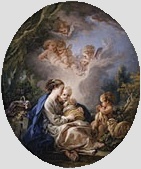

When seen in certain particular situations, the Virgin Mary's image may be referred to as a pietà or a sacra conversazione. She is often shown as radiating an aura called variously a halo, a gloriole or glory,or a mandorla.
In contemporary popular art, the stage name of the American singer and actress Louise Veronica Ciccone.
Examples of works depicting the former:

Simone Martini (Italian, c. 1284-1344), Madonna from the Annunciation, 1340-1344,
tempera on wood
panel, 12 x 8 1/2 inches (30.5
x 21.5 cm), State Hermitage Museum, St. Petersburg, Russia.

Byzantium, The Cambrai Madonna, c. 1340, Metropolitan
Museum of Art. About a hundred years after it was produced, Canon
Fursy de Bruille acquired this icon
in Rome. He was told that it was a holy relic:
it had been painted by St. Luke himself. In 1440, the canon gave
the painting to the Cathedral of Cambrai, France, where thousands
of pilgrims saw it. The image
shows Jesus squirming in his mother's arms. Mother and child,
doleful and shy, turn slightly toward us, as if they are watching
or waiting for something. The Cambrai Madonna conforms to a type,
"the Virgin of Tenderness," an invention of the late
Byzantine era. See Byzantine
art.

Robert Campin (Master of Flemalle) (Netherlandish,
active, 1406-1444), Madonna and Child before a Fireplace,
oil on wood
panel, 13 x 9 1/2 inches (34.3
x 24.5 cm), Hermitage Museum, St. Petersburg, Russia.
Donatello (Italian, 1386-1466), Pazzi Madonna, c. 1422, marble relief, 74.5 x 69.5 cm, Bodemuseum, Berlin. See a Donatello site [text in Italian].

Dieric Bouts (Netherlandish, active by 1457,
died 1475), Virgin and Child, c. 1455-60, oil
on wood panel,
8 1/2 x 6 1/2 inches (21.6 x 16.5 cm), Metropolitan Museum of
Art, NY.
Giovanni Bellini (Italian, 1430/40-1516), Madonna with Saints, 1505, altar painting: oil on wood, transferred to canvas, 158 1/2 x 102 1/2 inches (402 x 273 cm), church of St. Zaccaria, Venice.
Sandro Botticelli (Italian, 1444/5-1510), Madonna of the Magnificat, c.1485, tempera on wood panel, tondo, diameter 118 cm, Uffizi, Florence.
Sandro Botticelli, Madonna of the Pomegranate, Madonna and Child and six Angels, c. 1487, Uffizi, Florence.

Leonardo da Vinci (Italian, 1452-1519), Madonna with a Flower (Benois Madonna),
begun 1478, oil on canvas, 19 1/2 x 12 1/2 inches
(49.5 x 33 cm), State Hermitage Museum, St. Petersburg, Russia.
See sfumato.

Leonardo da Vinci, Madonna Litta, c. 1490-91, tempera
on canvas, transferred
from panel, 16 1/2 x 13 inches
(42 x 33 cm), Hermitage, St. Petersburg, Russia. See sfumato.

Gerard David (Netherlandish, born about 1455,
died 1523), The Rest on the Flight into Egypt, c.
1512-15, oil on wood
panel, 20 x 17 inches (50.8 x 43.2
cm), Metropolitan Museum of Art, NY. See chiaroscuro,
drapery, Northern Renaissance, and vignette.

Lucas Cranach the Elder (German, 1472-1553),
The Virgin and Child under an Apple Tree,
1520-1526, oil on canvas
(transferred from panel), 34 x
23 inches (87 x 59 cm), Hermitage Museum, St. Petersburg, Russia.

Michelangelo Buonarroti (Italian, 1475-1564),
Madonna of the Stairs, 1489-92, marble bas-relief, 21 3/4 x 15 3/4 inches (height
55.5 cm), Casa Buonarroti, Florence. Perhaps the earliest of
his sculptures to survive,
Michelangelo conceived and executed this bas-relief when he was
between fourteen and seventeen years old. To see numerous other
sculptures by Michelangelo visit 1200 years of Italian Sculpture.

Raphael (Raffaello Sanzio or Santi) (Italian,
Marchigian, 1483-1520), Madonna and Child (Madonna Conestabile),
1502/3, tempera on canvas
(transferred from panel), 7 x 7
inches (17.5 x 18 cm), State Hermitage Museum, St. Petersburg,
Russia. See Renaissance.

Raphael (Raffaello Sanzio or Santi), Madonna and Child Enthroned with Saints,
altarpiece, c. 1504, tempera
and gold on wood; main panel,
overall 67 7/8 x 67 7/8 inches (172.4 x 172.4 cm), painted surface
66 3/4 x 66 1/2 inches (169.5 x 168.9 cm); lunette,
overall 29 1/2 x 70 7/8 inches (74.9 x 180 cm), painted surface
25 1/2 x 67 1/2 inches (64.8 x 171.5 cm), Metropolitan Museum
of Art, NY. (On the Met's page, you can enlarge any detail.)
Raphael (Raffaello Sanzio or Santi), The small Cowper Madonna, c. 1505, oil on wood panel, 23 3/8 x 17 3/8 inches (59.5 x 44 cm), National Gallery of Art, Washington, DC.
Raphael (Raffaello Sanzio or Santi), Granduca Madonna, c. 1505, oil on wood panel, 33 x 21 1/2 inches (84 x 55 cm), Pitti Palace, Florence.

Raphael (Raffaello Sanzio or Santi), The Holy Family (Madonna with the Beardless Joseph),
1506, tempera on canvas
(transferred from panel), 28 1/2
x 22 1/2 inches (72.5 x 56.5 cm), Hermitage Museum, St. Petersburg,
Russia.

Titian (Tiziano Vecellio) (Italian [Venetian],
1477/901576), Madonna with saints and members of the Pesaro
family, 1519-26, altar-painting: oil
on canvas, 188 1/8 x 104
3/4 inches (478 x 266 cm), Church of Sta Maria dei Frari, Venice.
Attributed to Jacopo Carrucci da Pontormo (Italian, Florence, 1494-1557), Madonna and Child with Two Angels, c. 1525, oil on linden wood panel, 40 1/4 x 31 inches, Legion of Honor, San Francisco. See Mannerism.
Elisabetta Sirani (Italian, 1638-1665), Virgin and Child, 1663, oil on canvas, 34 x 27 1/2 inches, National Museum of Women in the Arts, Washington, DC. See Baroque.
![]()
Francesco de Mura (Italian, Naples, 1696-1782),
The Madonna and Child with the Infant St. John,
18th century, oil on copper, 10 1/4 x 8 inches, Minneapolis
Institute of Arts.

François Boucher (French, 1703-1770),
Virgin and Child with the Young Saint John the
Baptist and Angels, 1765, oil
on canvas; oval,
16 1/8 x 13 5/8 inches (41 x 34.6 cm), Metropolitan Museum of
Art, NY. See Rococo.

Hippolyte (Paul) Delaroche (French, 1797-1856),
The Virgin and Child (Marie dans le desert),
1844, oil on canvas,
relined, 147.7 x 87.5 cm, Wallace Collection, London.

Franz Ittenbach (German, 1813-1879), Madonna
and Child, 1855, oil
on canvas, 43 3/4 x 33
3/4 inches, Minneapolis Institute of Arts. See German
art.

Ford Madox Brown (English, 1821-1893), 'Take your Son, Sir', c. 1851-92, oil on canvas,
70.5 x 38.1 cm, Tate Gallery, London. Although this image is
madonna-like, it does not necessarily depict Mary and Jesus.
Brown began it as a study of Emma, his second wife, but left
it incomplete until he introduced the figure of their infant
son five years later. This composition has most often been interpreted
as a celebration of marriage. The painting has also been considered
a contemporary life subject in which a kept woman offers her
illegitimate child to its father, who is seen reflected in the
mirror. See Pre-Raphaelite
Brotherhood.

Edvard Munch (Norwegian, 1863-1944), Madonna, 1895-1902, lithograph and woodcut, complete: 23 3/4 x 17 1/2 inches
(60.5 x 44.5 cm), edition: c. 250, Museum of Modern Art, NY.
This was exhibited in the influential Armory
Show of 1913. See Expressionism
and Symbolism.

G.K.Odell (Canadian), Keep these Hands Off! Buy the New Victory Bonds, c. 1941-45, poster commissioned by the Canadian government; National Archives and Records Administration, Washington, DC. Dark, claw-like hands marked with the Nazi swastika and Japan's rising sun threaten the safety of a mother and infant. Is this a Madonna or an analogy to a Madonna? See propaganda.
https://inform.quest/_art